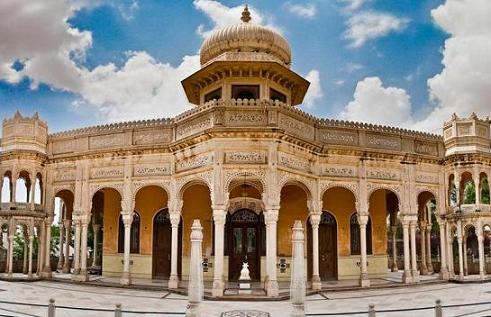In Rajasthan L’unico motivo per cui un viaggiatore visita la regione di Shekhawati, oltre a rilassarsi in un resort storico oa cavallo, è andare a caccia di affreschi. L’intero terreno è un enorme tesoro composto da dipinti e murales colorati.
“Shekhawati”, che significa “la terra del clan di Shekha”, deriva il suo nome da Rao Shekha (1433 d.C.-1488 d.C.) un rampollo della famiglia Kachhwaha di Jaipur. In precedenza una parte dell’ex stato di Jaipur, ora comprende i distretti di Jhunjhunu e Sikar. Mentre viaggi più vicino, vedrai sette principi, bloccati per sempre su un muro, con spade identiche e un aspetto tetro, forse perché sono rimasti così per oltre 60 anni. Benvenuti nella magica terra di Shekhawati, l’unico posto in India dove le pareti sono sempre state usate come una tela, dove i dipinti parlano più degli stessi locali. trasformare Shekhawati in un’enorme galleria d’arte all’aperto che delizia ogni conoscitore d’arte che viene qui per una vacanza. Oggi, la regione di Shekhawati racchiude entro i suoi confini un patrimonio culturale e storico estremamente prezioso che dovrebbe essere visitato prima che si perda nella polvere del tempo. Di seguito sono menzionati alcuni di questi luoghi – alcuni sembreranno familiari mentre altri straniero. Tuttavia, non esprimere alcun giudizio basato sulla “familiarità”, poiché anche la più remota della destinazione Shekhawati potrebbe generare una sorpresa non vista altrove nella regione.
Famosi Shekhawati Places
Nawalgarh – Nominato dal suo fondatore Thakur Nawal Singh (figlio del sovrano di maggior successo di Shekhawati, Shardul Singh), Nawalgarh era una prospera città nella regione dello Shekhawati. Alcuni dei ricchi clan commerciali dell’India oggi tracciano la loro origine da Nawalgarh. Tra questi spicca la famiglia Goenka. Gli haveli della città – Aath haveli, Murarka Haveli, Khedwal Bhawan, Bhagton ki Haveli e Anandi Lal Poddar Haveli – sono la sua principale attrazione. Gli affreschi e le pitture murali sono estremamente attraenti e riflettono le capacità degli operai che li hanno creati. Un’altra attrazione di Nawalgarh è il Tempio di Ganga Mai.
Dundlod – Un piccolo villaggio nella regione di Shekhawati è noto per un piccolo forte costruito nel 18 ° secolo da Kesri Singh, il figlio più giovane di Sardul Singh. Il forte ha un Diwan Khana con ritratti e mobili d’epoca e una piccola biblioteca. Il forte ora funge da hotel. Altre attrazioni da visitare qui sono Tuganram Goenka Haveli, SatyaNarayan Temple e Jagathia Haveli. Questo villaggio si trova a 7 km a nord di Nawalgarh.
Fatehpur – Fondato da Fateh Khan, un musulmano Nawab nel 15 ° secolo, Fatehpur fu catturato dagli Shekhawat Rajput nel XVIII secolo. Il luogo vanta alcuni dei migliori affreschi della regione, tuttavia, sfortunatamente, gli haveli che li ospitano sono più spesso chiusi a chiave. Vale la pena vedere gli haveli in questo luogo: Geori Shankar Haveli, Mahavir Prasad Goenka Haveli, Nand Lal Devra Haveli e Jagannath Singhania Haveli. C’è anche il Jagannath Singhania Chattri con un bellissimo giardino che vale la pena visitare.
Ramgarh – Circa 20 km da Fatehpur si trova Ramgarh, fondato nel XVIII secolo da un gruppo di ricchi mercanti Poddar. L’attrazione principale della città è Ram Gopal Poddar Chhatri che ha delle bellissime scene di Ramayana dipinte sui suoi soffitti. Dipinti affreschi in Shani Mandir (Tempio di Saturno) attirano l’attenzione. Altre attrazioni del luogo includono il Tempio di Ganga, il Tempio di Ganes, il Tarachand Ghanshyamdas Poddar Haveli e il Baij Nath Ruia Haveli.
Jhunjhunu – Attualmente quartier generale del distretto, Jhunjhunu è stata fondata da Kaimkhani Nawabs nel XV secolo. Luoghi degni di essere visitati in questa città sono Badani Chand Well, Mertani Baori, Ajit Sagar, Dargah di Kamrud-din Shah, Badal Fort, Khetri Mahal, Bihariji Temple, Rani Sati Temple e Forest Ganj. Gli haveli significativi di questo posto sono Modi Haveli, Kaniram Narsingh Das Tiberwala Haveli, MohanDas Ishwar Das Modi Haveli e Narudin Farooqi Haveli.
Mandawa – Una delle destinazioni più visitate nella regione di Shekhawati, Mandawa è entrata in scena nel XVIII secolo. Ha un imponente forte, Castle Mandawa che oggi funge da hotel storico. Altre attrazioni della città includono gli haveli di Chokhanias, Goenkas Nevatia e Ladia e Saraf. Parasrampura – Il piccolo villaggio conserva alcuni dei dipinti più antichi e più belli della regione di Shekhawati. I dipinti sulla parte interna della cupola del cenotafio Thakur Shardul Singh, Shamji Saraf Haveli e Gopinathji Mandir meritano di essere apprezzati.
Sikar – Ora quartier generale del distretto, Sikar era una volta il più grande thikana (feudatario) sotto lo stato di Jaipur. Importanti attrazioni qui sono gli haveli di Biyani, Murarka, Somani, Sagarmal Sodhani e Madho Niwas. Vale la pena visitare anche il Sikar Fort, la Jubilee Hall, i templi Jain, il Tempio di Gopinath, il Tempio di Raghunath, il Tempio di Jeen Mata e il Tempio di Madan Mohan.
Khetri – Il secondo più ricco feudatario dello stato di Jaipur, Khetri fu fondato nel XVIII secolo. Luoghi importanti da visitare sono il Tempio di Raghunath, il Forte di Bhopagarh, il Panna Lal Sha ka Talab, la Missione di Ram Krishna, il Sukh Mahal e il Tempio di Hari Singh. Pilani – Questo piccolo villaggio ha guadagnato importanza come la casa della ricca famiglia Birla. Oggi, il luogo è più noto per il suo significato educativo. Per i turisti che visitano, c’è il museo BITS, Shiva, Ganga, il Tempio di Sarswati e il Tempio di Panchwati.
Turismo del Rajasthan
Rajasthan Autonoleggio
Pacchetti turistici del Rajasthan
